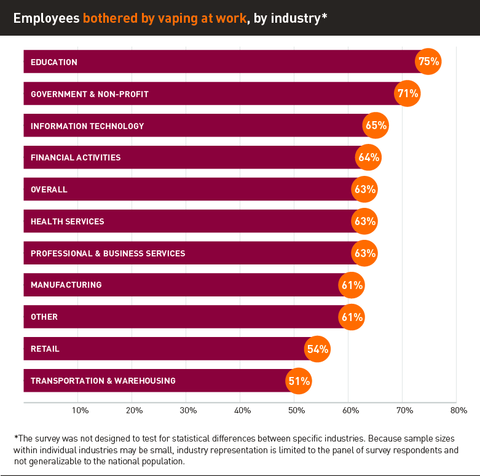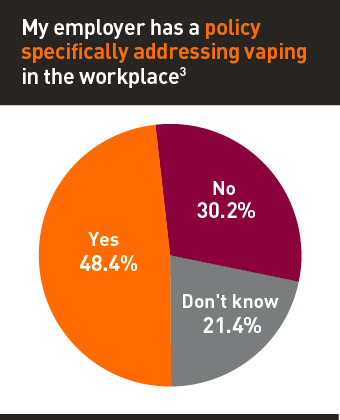Vaping in the Workplace
Regulations on vaping in the workplace are piecemeal at best, with less than half of states explicitly banning e-cigarette use in workplaces. With more service and industry workers back in the workplace and many more contemplating a return to in-person work amid the ongoing COVID-19 pandemic, regulations on workplace vaping to protect employee health have never been more important.
Vaping in public spaces is a cause for concern for a number of reasons. E-cigarettes degrade indoor air quality and expose bystanders to risks associated with secondhand exposure, according to a 2020 review published in the Annual Review of Public Health. E-cigarettes also generate indoor particle concentrations similar to those produced by cigarettes, including toxic compounds such as aldehydes and heavy metals and aerosols that have potential respiratory and cardiovascular effects in humans.
Until now, limited research existed on how employees are exposed to or affected by workplace vaping. A series of pioneering peer-reviewed research articles from Truth Initiative published in academic journals reveal that vaping pervades the workplace with more than three-fourths (76%) of e-cigarette users vaping at work, triggering the urge to smoke and vape in nearly half of tobacco users. In the first study to look at vaping rates in medium and large U.S. workplaces, Truth Initiative finds that vaping is ubiquitous and bothersome to many.
The research also shows high levels of support (73.5%) for e-cigarette-free workplaces from those who don’t vape — the majority of any workforce — as well as from e-cigarette users themselves (53.5%). Given the numerous drawbacks of vaping at the workplace and widespread support for a vape-free environment, it’s no surprise that most adult e-cigarette users (62%) have plans to quit e-cigarettes for good. However, although quit-vaping support is important to the vast majority (84.8%) of employees, only one-third (31%) of workplaces have such cessation programs in place.
The health risks of vaping in shared workspaces — especially risks to lung health — threaten the safety of employees as they return to in-person work in environments with the ever-present risk of COVID-19. Findings from these studies speak to the clear need for employers to address gaps in workplace policies and to provide employees with support to quit vaping.

Regulations on workplace vaping to protect employee health have never been more important.
COVID-19, vaping and returning to the workplace safely
The virus that causes COVID-19 attacks the lungs and poses a serious threat to tobacco users, both smokers and vapers.
Smoking is a known risk factor for the progression of COVID-19 and is associated with more severe outcomes. E-cigarette use isn’t harmless to users and those around them and there is growing evidence that vaping can harm lung health and increase the risk of testing positive for COVID-19.
Behaviors endemic to workplaces — including congregating with others, sharing cigarettes or vaping devices, removing face masks and exhaling smoke or vapor that contains respiratory droplets — are potential pathways for virus transmission.
It is critical to recognize vaping as a potential health risk when it comes to reopening workplaces during the COVID-19 pandemic. Significant aspects of successful reopening should include developing and implementing a plan for keeping public spaces like workplaces clean and disinfected, and ensuring that employees have adequate ventilation, according to the Centers for Disease Control. The CDC also suggests conducting a hazard assessment of the workplace.
As the country transitions back to more in-person work, employers should prohibit vaping in the workplace and provide tools to help their employees quit all forms of tobacco to promote healthy, safe workplaces.
VAPING PERVADES THE WORKPLACE
A Truth Initiative study published in the Journal of Occupational and Environmental Medicine finds that it is increasingly pervasive: more than three-fourths (76%) of e-cigarette users reported vaping at work themselves — nearly one-fifth (19.1%) of the surveyed population. The majority of adults surveyed (61.6%) observed coworkers vaping at work. The study surveyed 1,607 U.S. adults aged 18-65 employed full-time with companies with 150+ employees in November 2019, when widespread work-from-home policies hadn’t yet been implemented in response to COVID-19.
Nearly all (98.6%) participants reported seeing coworkers vaping outdoors, but vaping occurs indoors too: over half (57.7%) reported seeing coworkers vape indoors, 98% reported seeing coworkers take breaks to vape, and most reported seeing or smelling vapor at work (90.3% and 75.6%, respectively). Those who vape indoors do not appear to limit vaping to leisure time: nearly 60% (57.5%) of respondents indicated that a coworker had vaped while conducting business with them or while in the respondents’ workspace, and 16.9% of respondents reported that this happened often.
WORKPLACE VAPING BOTHERS MOST AND DECREASES PRODUCTIVITY
With most e-cigarette users vaping at work and the majority of employees reporting seeing coworkers vaping indoors, it may be difficult to escape being exposed to workplace vaping. Research shows that workplace vaping bothered most adults (63.2%), although rates varied by industry:
Most adults surveyed also perceived workplace vaping as moderately harmful with an average of 1.9 on a scale from 0-3 (higher scores representing higher perceived harm) and thought it decreased workplace productivity among non-users (52.1%).
Employees who do not use tobacco products were much more likely to have negative perceptions of workplace vaping than e-cigarette users. Non-tobacco users comprised 59% of the sample and make up an even larger share of the U.S. workforce.
WORKPLACE VAPING TRIGGERS OTHERS’ TOBACCO USE
Observing coworkers vaping at work may be more than just a bothersome productivity sink — it may also trigger tobacco use. In a related Truth Initiative study published in Journal of Occupational and Environmental Medicine, nearly half of current tobacco users (46%- 48%) reported workplace vaping as a trigger for their own vaping and smoking, respectively, and 7% of former users reported it as a trigger. Smokers were roughly twice as likely as e-cigarette users to report that seeing someone vape at work was a trigger for them to smoke, and those who used both cigarettes and e-cigarettes were more than three times as likely than e-cigarette-only users to report that seeing someone vape at work was a trigger for them to smoke. These findings suggest that vaping in the workplace might undermine the efforts of those trying to quit and put those who have successfully quit at risk for relapse.

Vaping in the workplace might undermine the efforts of those trying to quit and put those who have successfully quit at risk for relapse.
RESTRICTIONS ON WORKPLACE VAPING ARE NOT COMMON DESPITE EMPLOYEE SUPPORT FOR SUCH POLICIES
Smoke-free air policies have been shown to increase cessation attempts, decrease cigarette consumption, and ultimately, reduce smoking prevalence. It is possible that prohibiting e-cigarette use in the workplace would support cessation in a similar way.
In research published in the American Journal of Health Behavior, Truth Initiative found that the majority of current e-cigarette users (53.5%) support vaping policies at work and nearly three-quarters (73.5%) of employees supported e-cigarette-free workplaces, in a sample of U.S. adults working for mid-size companies in November 2019. Never users and former e-cigarette users were significantly more likely to support e-cigarette workplace policies compared to current e-cigarette users.
Despite overwhelming support for having vaping policies at work, most workplaces don’t have such policies in place. Less than half of working adults (48.4%) reported that their employer had a formal, written policy specifically addressing e-cigarette use, 30.2% reported their employer did not have such a policy and 21.4% reported that they did not know.
Given high levels of support for workplace e-cigarette policies, there is clear room for improvement when it comes to implementing clean indoor air policies that include e-cigarettes and increasing employee awareness of these policies.
THE NEED FOR WORKPLACE QUIT VAPING PROGRAMS FOR EMPLOYEES AND FAMILIES
In addition to comprehensive tobacco-free policies that specifically address e-cigarettes, employees and families need help to quit vaping. The majority of adult e-cigarettes users plan to quit and most young people who vape want to stop.
More than eight in 10 respondents (84.8%) said a workplace that supports quitting e-cigarettes is important to them, with broad support across non-tobacco users as well as smokers, e-cigarette users and those using both products concurrently.
The Truth Initiative study found that roughly half — 48.6% — of all employees said they would use a quit vaping program themselves or to help a family member or child quit vaping. Among e-cigarettes users who intended to quit in the next six months, more than 70% said they would likely use medication or a digital tobacco cessation program. Despite the widespread support, only one-third (31%) of workplaces have such cessation programs in place.
Tobacco users are not the only ones in need of support. With 43.6% of high school students who vape reporting using e-cigarettes on 20 or more of the past 30 days, almost daily, many working parents are affected by teen vaping. Among parents who reported that their child used e-cigarettes or that they weren’t sure, 43.4% reported feeling anxious or worried about it during the workday, 27.3% reported missing work as a consequence, 29.3% reported being less productive as a consequence, and 35.4% reported having difficulty focusing on work as a consequence. This kind of “presenteeism” — an employee being present at work whilst they’re unwell — can have dangerous consequences for employees working in certain industries. Providing tailored support to the one-third of working parents who are affected by child vaping could have a powerful impact on reducing absenteeism and presenteeism.

The majority of adult e-cigarettes users plan to quit and most young people who vape want to stop.
The EX Program helps companies help their employees quit tobacco
The EX Program is a tobacco cessation program designed for employers and health plans. It combines scientific leadership in digital tobacco cessation from Truth Initiative with clinical expertise from Mayo Clinic. The EX Program includes:
- a personalized quit plan with interactive, skill-building exercises
- live chat coaching with cessation experts
- the longest-running and largest online support community of current and former tobacco users
- text messaging that is dynamically tailored to participants throughout their quitting journey
- quit medication decision support and home delivery.
Visit theexprogram.com for details.
EMPLOYER-BASED QUIT-VAPING PROGRAMS CAN PLAY A CRITICAL ROLE IN OVERALL EMPLOYEE HEALTH
As employers navigate a safe and healthy return to the workplace, tobacco cessation should be front and center. Digital tobacco cessation programs are uniquely poised to help tobacco users quit and stay quit during the extraordinary challenges of this global pandemic and beyond. Digital interventions yield quit rates comparable to face-to-face and telephonic interventions but are available to everyone with a cell phone, making them safer and more accessible in a socially distanced environment. Digital programs are available around the clock, whenever a tobacco user needs support, and connect tobacco users to an online community so they can remain connected with a support network. Digital programs can also connect tobacco users with the right nicotine replacement medication and have it shipped to them, providing uninterrupted access to a critical component of cessation treatment. Reaching more tobacco users and providing them with ready access to the tools they need to help them quit translates to the ability to have a greater impact on the workforce.
Adding vaping to your tobacco-free workplace policy
If you’re ready to add vaping to your workplace tobacco-free policy, you can get started with the tips and steps below from The EX Program blog, which also appeared on Talent Culture.
Make your workplace policy comprehensive
Start by ensuring that your no-smoking-at-work policy prevents exposure to secondhand smoke for all your employees, whether they work indoors or outdoors. Take a look at the American Nonsmokers’ Rights Foundation for a model policy that’s easy to follow.
Know your state and local laws
E-cigarettes are regulated at state and local levels, and it’s helpful to know where your state and municipality might stand. The American Nonsmokers’ Rights Foundation has maps with information specific to your company’s location.
Handle smoking and vaping consistently
Your policy should be clearly written and understandable, articulating the same terms for enforcement for e-cigarette users and other types of tobacco users as for cigarette smokers.
Communicate the new policy with employees
Once your newly revised policy is developed, share it with employees in many different shapes and forms to meet your employees where they are: intranet posts, manager talking points and company-wide meetings, for example. It can take multiple attempts for employees to become aware of and comprehend messages from HR teams.
Provide access to quit support
Modifying your existing tobacco-free policy to include vaping may also represent a powerful opportunity to re-engage smokers in a cessation benefit, so take this as a chance to remind smokers of resources already offered by your company. Employees need to know there is tailored support available to help them quit tobacco use.
CONCLUSION: VAPE-FREE WORKPLACES ARE MORE IMPORTANT THAN EVER IN A COVID-19 ERA
Vaping in the workplace is bothersome, decreases productivity and poses a threat to employee health. For employers, tobacco use has a direct impact on the bottom line. Beyond these negative consequences, research suggests that e-cigarette use in public places — including those designated as smoke-free such as restaurants and workplaces — could actually renormalize tobacco use and erode firmly established social norms that disapprove of smoking in public places. Allowing tobacco use in these spaces to once again become normalized undermines decades of efforts to the contrary.
Employees overwhelmingly support restrictions on vaping in the workplace as well as easily accessible programs to help users quit. Yet only 19 states have explicitly banned e-cigarettes in non-hospitality workplaces and most adult e-cigarette users report that they had vaped in a public space where cigarettes were not allowed with very few negative reactions.
Until clean indoor air laws and requirements that include e-cigarettes are universally adopted at the federal, state and local level, employers should take action to prohibit tobacco use and encourage cessation. Resources to enact clean indoor air workplace policies can help employers begin the process of protecting employee health. While companies prepare the adjustments needed to protect their employees from the current pandemic, they can also implement basic guidelines to ensure a smoke- and vape-free workplace.

Employers should take action to prohibit tobacco use and encourage cessation.
More in emerging tobacco products
Want support quitting? Join EX Program
By clicking JOIN, you agree to the Terms, Text Message Terms and Privacy Policy.
Msg&Data rates may apply; msgs are automated.





